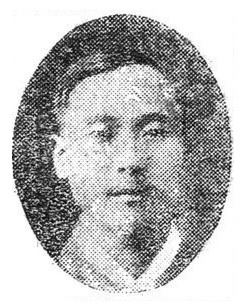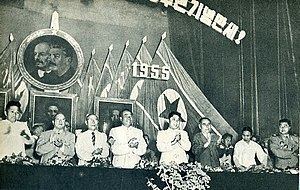Choson'gul 김두봉 Choson'gul 백연 Died 1958 McCune–Reischauer Kim Tubong Role Politician | Revised Romanization Gim Dubong Name Kim Tu-bong Hancha 金枓奉 Hancha 白淵 | |
 | ||
Kim Tu-bong (February 16, 1889 – March 1958 or later) was the 1st Chairman of the Central Committee of the Workers' Party of North Korea from 1946 to 1948. He was known in Korean history as a linguist, scholar, and politician. His most famous work was under Ju Sigyeong; later, after participating in the March 1st Movement, he with other Korean leaders of the time established a provisional government-in-exile in China, and because of his communist beliefs he played an important role in the early North Korean communist regime.
Contents
- Early childhood and education
- Early linguistic work
- Shanghai and the exiled Korean Government
- Return home and the new government
- Disappearance and death
- References

He and other members of the Yan'an faction formed the New People's Party when they returned from exile. After the New People's Party merged into the Workers Party of North Korea (WPNK) in 1946 at the 1st WPNK Congress, he became WPNK Chairman. He was the first head of state (Chairman of the Standing Committee of the Supreme People's Assembly) of North Korea from 1948 to 1957. He is most remembered in South Korea for his efforts in establishing the Korean linguistic field and especially that of Hangul. Much of his work both political and linguistically was done while living in China with the exiled government of Korea. He is also known by his pen name Baekyeon. He was purged by Kim Il-sung in 1957.
Early childhood and education
Born on February 2, 1889, in South Korea's South Gyounghee Provenance, near modern-day Pusan, he spent his early years being homeschooled during the time of imperial rule. He would move to Seoul at the age of 20 (1908) to attend both Geho School and Baechae School and in that same year graduate from Bogo High School. While he was in Seoul he would join the Korea Youth organization in 1913 and the following year (1914) leave Baechae School. He was also an editor for the So nyoun magazine.
Early linguistic work
After graduating from Bosungkobo (Bosung College) in 1908, Kim Tu-bong worked closely with a Linguistic professor from Bosungkobo named Ju Sigyeong who was at that time beginning his work in the study of Hangul for which his name would later be known for as he would dedicate his life to bring it about (the Korean script made by King Sae Jeong during the 15th century). He also worked as a teacher. In 1916 he spent a majority of his time working on compiling MalMooe, the first Korean dictionary.
Shanghai and the exiled Korean Government
After the March 1st Movement (March 1, 1919) he and other members of the independence club fled into China and in April 1919 set up a provisional government in Shanghai. During which he was first exposed to Communism and eventually accepted it in 1920 after first supporting the Democratic Party. In 1924 he was entrusted with the department of children education and schooling where he served as the president and also taught both Korean and Korean History. After the Japanese invaded China he and other members of the Korean government in Shanghai fled to Yan'an, and there Kim would become the head of the independence club and became a very important figure in combining the conflicting views of both communist and democratic ideas.
Return home and the new government
The December following World War II and the Japanese's surrender (August 15, 1945) Kim Tu-bong and other members returned to the then-divided Korea. Like many other Communist-minded people of the time, Kim Tu-bong and other Communist leaders took residence in what is now North Korea under the Soviet occupation. In February 1946 Kim Tu-bong became the chairman of the new People's Party. Later that year in August it merged to form the Workers' Party. He would become the chairman in 1948; Kim designed the new flag that is still used in North Korea today in an effort to throw off what he saw as feudal rule.
Disappearance and death
After the Korean War Kim Tu-bong had served his usefulness in the government and whether imagined or real many scholars believe at this point he now became a perceived threat to Kim Il-sung's dictatorship. Rumors began that it had to do with a scandal as he had married a much younger woman later in life. Whatever the reason, he disappeared around 1958 and, like many others of Kim Il-sung's political opponents, he disappeared with no records to indicate whether he had been sentenced to hard labor or exile, but his death was finally announced in 1960.
